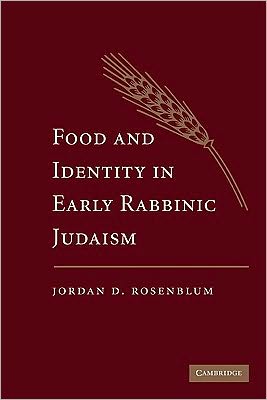Food and Identity in Early Rabbinic Judaism
Food often defines societies and even civilizations. Through particular commensality restrictions, groups form distinct identities: Those with whom “we” eat (“Us”) and those with whom “we” cannot eat (“Them”). This identity is enacted daily, turning the biological need to eat into a culturally significant activity. In this book, Jordan D. Rosenblum explores how food regulations and practices helped to construct the identity of early rabbinic Judaism. Bringing together the scholarship of...
Search in google:
"In this book, Jordan D. Rosenblum explores how food regulations and practices helped to construct the identity of early rabbinic Judaism"--Provided by publisher."Food often defines societies and even civilizations. Through particular commensality restrictions, groups form distinct identities: Those with whom "we" eat ("Us") and those with whom "we" cannot eat ("Them"). This identity is enacted daily, turning the biological need to eat into a culturally significant activity. In this book, Jordan D. Rosenblum explores how food regulations and practices helped to construct the identity of early rabbinic Judaism. Bringing together the scholarship of rabbinics with that of food studies, this volume first examines the historical reality of food production and consumption in Roman-era Palestine. It then explores how early rabbinic food regulations created a distinct Jewish, male, and rabbinic identity. Rosenblum's work demonstrates how rabbinic food practices constructed an edible identity"--Provided by publisher.
AcknowledgmentsAbbreviationsIntroduction 1"The Set Table": Organization and Structure 10A Brief Introduction to the Tannaitic Corpus 131 Realia 15What Did They Eat? 17How Did They Obtain Their Food? 22How Did They Prepare Their Food? 24In What Manner Did They Eat Their Food? 30Realia: Conclusions 332 Jewish Identity 35Pre-Tannaitic Evidence for Commensality Restrictions 36Food as Metonym/Food as Embodiment 45The "Abominable Pig" 48Manna 58The Passover 63The Laws of Kashrut 68Food as Metonym/Food as Embodiment: Conclusions 73The Status of Food Correlates with the Status of Its Cook 75Meat 76Non-Meat Items 81Conclusions 89Commensality as Idolatry 91Jewish Identity: Conclusions 1013 Jewish Male Identity 103Preparing Food as (Re)Producing Male Identity 104Sharing the Kitchen with the Haber and the 'Am ha' Ares 117Preparing Food as (Re)Producing Male Identity: Conclusions 120Women at the Tannaitic Table? 123"It Leads to Transgression": Commensality Among Zabim 132Jewish Male Identity: Conclusions 1354 Jewish Male Rabbinic Identity 138The Cuisine of the Rabbinic Jew 140Purity and Commensality 143Commensality between the Haber and the 'Am ha' Ares 146Purity and Commensality: Conclusions 153The Status of Food Correlates with the Status of Its Cook 154Reinterpreting Festival Observance 161Passover 162Sukkot 170The Sabbath 174Commensality and the Synagogue 178Jewish Male Rabbinic Identity: Conclusions 182Conclusion 185Bibliography 193Selected General Index 209Index of Pre-Modern Sources 212Selected Index of Modern Scholars 220








